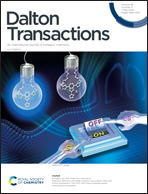Efficient removal of methyl orange by a flower-like TiO2/MIL-101(Cr) composite nanomaterial†
Abstract
Nano-scale MOF composite materials prepared by combining inorganic semiconductors with controllable pore structures and functional active sites for the effective removal of organic dyes will exhibit more excellent adsorption activity. In this paper, MIL-101(Cr) was used as a carrier and two-step hydrothermal methods were successfully used to prepare flower-like TiO2/MIL-101(Cr) composite nano-adsorbents with different sizes. The results of XRD, SEM, XPS and other characterization methods showed that when the molar ratio of Ti : Cr was 0.2 : 1, the composite nano-adsorbent exhibited better adsorption performance and removal efficiency for methyl orange (MO) in aqueous solution. By assembling TiO2 on MIL-101(Cr), Ti replaced part of Cr, and the positively-charged TiO2/MIL-101(Cr) nanocomposite and negatively-charged MO in aqueous solution formed a strong interaction force. In addition, the π–π packing interactions of the benzene ring of MIL-101(Cr) and the electrostatic force between TiO2 and MIL-101(Cr) also enhanced the performance and adsorption efficiency of the adsorbent to a certain extent. The BET results showed that the large specific surface area and average pore diameter of the TiO2/MIL-101(Cr) nanocomposites effectively improved the adsorption performance of the composites. The results showed that the MO removal efficiency of 20% TiO2/MIL-101(Cr) can reach 93.03% at 80 min. But when 20% TiO2/MIL-101(Cr) was used to adsorb 70 mg·L−1 MO, the experimental maximum adsorption capacity was 242.02 mg·g−1.



 Please wait while we load your content...
Please wait while we load your content...